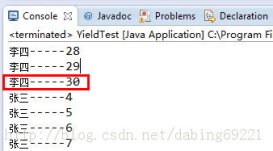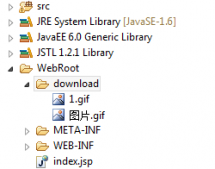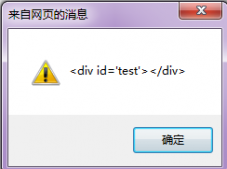1. 调试追踪代码:
|
1
2
3
4
5
6
7
8
9
10
11
|
public static void enterTryMethod() { System.out.println("enter after try field"); } public static void enterExceptionMethod() { System.out.println("enter catch field"); } public static void enterFinallyMethod() { System.out.println("enter finally method"); } |
2. 抛出Exception,没有finally,当catch遇上return
|
1
2
3
4
5
6
7
8
9
10
11
12
|
public static int catchTest() { int res = 0; try { res = 10 / 0; // 抛出Exception,后续处理被拒绝 enterTryMethod(); return res; // Exception已经抛出,没有获得被执行的机会 } catch (Exception e) { enterExceptionMethod(); return 1; // Exception抛出,获得了调用方法并返回方法值的机会 } } |
后台输出结果:
|
1
2
|
enter catch field 1 |
3. 抛出Exception,当catch体里有return,finally体的代码块将在catch执行return之前被执行
|
1
2
3
4
5
6
7
8
9
10
11
12
13
14
|
public static int catchTest() { int res = 0; try { res = 10 / 0; // 抛出Exception,后续处理被拒绝 enterTryMethod(); return res; // Exception已经抛出,没有获得被执行的机会 } catch (Exception e) { enterExceptionMethod(); return 1; // Exception抛出,获得了调用方法并返回方法值的机会 } finally { enterFinallyMethod(); // Exception抛出,finally代码将在catch执行return之前被执行 } } |
后台输出结果:
|
1
2
3
|
enter catch field enter finally method 1 |
4. 不抛出Exception,当finally代码块里面遇上return,finally执行完后将结束整个方法
|
1
2
3
4
5
6
7
8
9
10
11
12
13
14
15
|
public static int catchTest() { int res = 0; try { res = 10 / 2; // 不抛出Exception enterTryMethod(); return res; // 获得被执行的机会,但执行需要在finally执行完成之后才能被执行 } catch (Exception e) { enterExceptionMethod(); return 1; } finally { enterFinallyMethod(); return 1000; // finally中含有return语句,这个return将结束这个方法,不会在执行完之后再跳回try或者catch继续执行,方法到此结束 } } |
后台输出结果:
|
1
2
3
|
enter after try field enter finally method 1000 |
5. 不抛Exception,当finally代码块里面遇上System.exit()方法将结束和终止整个程序,而不只是方法
|
1
2
3
4
5
6
7
8
9
10
11
12
13
14
15
|
public static int catchTest() { int res = 0; try { res = 10 / 2; // 不抛出Exception enterTryMethod(); return res; // 获得被执行的机会,但由于finally已经终止程序,返回值没有机会被返回 } catch (Exception e) { enterExceptionMethod(); return 1; } finally { enterFinallyMethod(); System.exit(0); // finally中含有System.exit()语句,System.exit()将退出整个程序,程序将被终止 } } |
后台输出结果:
|
1
2
|
enter after try field enter finally method |
6. 抛出Exception,当catch和finally同时遇上return,catch的return返回值将不会被返回,finally的return语句将结束整个方法并返回
|
1
2
3
4
5
6
7
8
9
10
11
12
13
14
15
|
public static int catchTest() { int res = 0; try { res = 10 / 0; // 抛出Exception,后续处理将被拒绝 enterTryMethod(); return res; // Exception已经抛出,没有获得被执行的机会 } catch (Exception e) { enterExceptionMethod(); return 1; // Exception已经抛出,获得被执行的机会,但返回操作将被finally截断 } finally { enterFinallyMethod(); return 10; // return将结束整个方法,返回值为10 } } |
后台输出结果:
|
1
2
3
|
enter catch field enter finally method 10 |
7. 不抛出Exception,当finally遇上return,try的return返回值将不会被返回,finally的return语句将结束整个方法并返回
|
1
2
3
4
5
6
7
8
9
10
11
12
13
14
15
|
public static int catchTest() { int res = 0; try { res = 10 / 2; // 不抛出Exception enterTryMethod(); return res; // 获得执行机会,但返回将被finally截断 } catch (Exception e) { enterExceptionMethod(); return 1; } finally { enterFinallyMethod(); return 10; // return将结束整个方法,返回值为10 } } |
后台输出结果:
|
1
2
3
|
enter after try field enter finally method 10 |
结论
Java的异常处理中,程序执行完try里面的代码块之后,该方法并不会立即结束,而是继续试图去寻找该方法有没有finally的代码块
如果没有finally代码块,整个方法在执行完try代码块后返回相应的值来结束整个方法
如果有finally代码块,此时程序执行到try代码块里的return一句之时并不会立即执行return,而是先去执行finally代码块里的代码
若finally代码块里没有return或没有能够终止程序的代码,程序在执行完finally代码块代码之后再返回try代码块执行return语句来结束整个方法。若 finally 代码块里有 return 或含有能够终止程序的代码,方法将在执行完 finally 之后被结束,不再跳回 try 代码块执行 return
在抛出异常的情况下,原理也是和上面的一样的,你把上面说到的 try 换成 catch 去理解就OK了。














